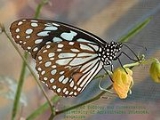
Tirumala limniace
Encyclopedia
The Blue Tiger is a butterfly found in India that belongs to the Crows and Tigers, that is, the Danaid group of the Brush-footed butterflies
family. This butterfly shows gregarious migratory behaviour in southern India
.
Underside: basal two-thirds of fore wing dusky black, the apex and hind wing olive-brown; the spots and streaks much as on the upperside, Antennae, head and thorax black, the latter two spotted and streaked with, white; abdomen dusky above, ochraceous spotted with white beneath. Male secondary sex-mark in form 1.
Expanse: 98–106 mm
 The butterfly larva generally feed on plants of Family Asclepiadaceae
The butterfly larva generally feed on plants of Family Asclepiadaceae
. The recorded host plants are :
quoted in Bingham)
during migration.
Nymphalidae
The Nymphalidae is a family of about 5,000 species of butterflies which are distributed throughout most of the world. These are usually medium sized to large butterflies. Most species have a reduced pair of forelegs and many hold their colourful wings flat when resting. They are also called...
family. This butterfly shows gregarious migratory behaviour in southern India
India
India , officially the Republic of India , is a country in South Asia. It is the seventh-largest country by geographical area, the second-most populous country with over 1.2 billion people, and the most populous democracy in the world...
.
Description
Upperside black, with bluish-white semihyaline spots and streaks. Fore wing: interspace 1 two streaks, sometimes coalescent, with a spot beyond cell: a streak from base and an outwardly indented spot at its apex; a large oval spot at base of interspace 2, another at base of interspace 3, with a smaller spot beyond it towards termen; five obliquely placed preapical streaks, and somewhat irregular subterminal and terminal series of spots, the latter the smaller. Hind wing: interspaces 1b, 1a, and 1 with streaks from base, double in the latter two, cell with a forked broad streak, the lower branch with a hook, or spur-like slender loop, at base of 4 and 5 a broad elongate streak, and at base of 6 a quadrate spot; beyond these again a number of scattered unequal subterminal and terminal spots.Underside: basal two-thirds of fore wing dusky black, the apex and hind wing olive-brown; the spots and streaks much as on the upperside, Antennae, head and thorax black, the latter two spotted and streaked with, white; abdomen dusky above, ochraceous spotted with white beneath. Male secondary sex-mark in form 1.
Expanse: 98–106 mm
Food-plants

Asclepiadaceae
According to APG II, the Asclepiadaceae is a former plant family now treated as a subfamily in the Apocynaceae...
. The recorded host plants are :
- AsclepiasAsclepiasAsclepias L. , the milkweeds, is a genus of herbaceous perennial, dicotyledonous plants that contains over 140 known species...
- CalotropisCalotropisCalotropis is a genus of flowering plants in the dogbane family, Apocynaceae. They are commonly known as milkweeds because of the sap they produce. Calotropis species are considered common weeds in some parts of the world. The flowers are fragrant and are often used in making floral tassels in...
- Heterostemma
- MarsdeniaMarsdeniaMarsdenia is a genus of plant in family Apocynaceae. It is named in honor of the plant collector and Secretary of the Admiralty, William Marsden.Species include:* Marsdenia australis* Marsdenia brachyloba* Marsdenia cavaleriei...
- Dregea volubilis
- Heterostemma cuspidatum
- Hoya viridiflora
- Marsdenia tenacissima
- CrotalariaCrotalariaCrotalaria is a genus of herbaceous plants and woody shrubs in the Family Fabaceae commonly known as rattlepods. Some 600 or more species of Crotalaria are described worldwide, mostly from the tropics; at least 500 species are known from Africa. Some species of Crotalaria are grown as ornamentals...
spp. - Epibaterium spp.
- Soya
Larva
Yellowish white; 3rd and 12th segments, each with a pair of fleshy filaments, black and greenish white; each of the segments with four transverse black bars, the second bar on all broader than the others, bifurcated laterally, a yellow longitudinal line on each side; head, feet and claspers spotted with black. The Larva is around 1.21 cms. in length and weighs around 5 mgs initially, but grows double that size and four times that weight within a period of forty eight hours.Pupa
"Green with golden scattered spots and beaded dorsal crescent" (Frederic MooreFrederic Moore
Frederic Moore FZS was a British entomologist. It has been said that Moore was born at 33 Bruton Street but may be incorrect given that this was the address of the menagerie and office of the Zoological Society of London from 1826 to 1836.Moore was appointed an assistant in the East India Company...
quoted in Bingham)
Habits
This species migrates extensively during the Monsoons in southern India. The migratory populations have been observed to be nearly entirely consisting of males. It is also known to mud-puddleMud-puddling
Mud-puddling is the phenomenon mostly seen in butterflies and involves their aggregation on substrates like wet soil, dung and carrion to obtain nutrients such as salts and amino acids. This behaviour has also been seen in some other insects, notably the leafhoppers.Lepidoptera are diverse in...
during migration.
See also
- Danainae
- NymphalidaeNymphalidaeThe Nymphalidae is a family of about 5,000 species of butterflies which are distributed throughout most of the world. These are usually medium sized to large butterflies. Most species have a reduced pair of forelegs and many hold their colourful wings flat when resting. They are also called...
- List of butterflies of India
- List of butterflies of India (Nymphalidae)

